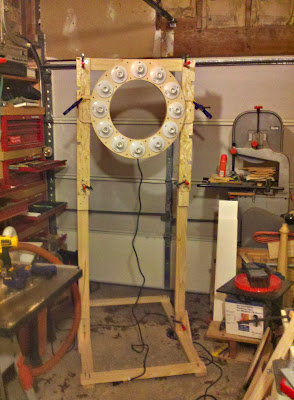As a none practical, handyman, DIY type person learning woodwork as a hobby, here are a few things I have realised during my steep learning curve over the last month or so since beginning working with wood. Most of these points you read about and are common sense, but I still had to go through the learning process myself before I got that ah now I get it moment of realisation ...
Like most physical activities the process of building something can be subdivided down into smaller components. For example the thought of building a complete table to a beginner can be quite daunting (remember I am talking about someone who has never built a thing out of wood in their life), but by considering the tables components almost as separate projects things seem to become easier.
A tables components might be table top, table legs and table skirt. Building each component can also be subdivided down into smaller processes such as marking out and cutting to size. By making each small sub process repeatable you quickly find yourself developing skills by habit and getting better and better each time you do them.

To start with (I found) using a pencil to mark out seemed normal and the marking knife seemed both a little strange and a little clumsy, you cant even see the knife lines as easy as a pencil! But it didnt take long before I realised just how much more accurate my lines and cuts became when using a marking knife. By forcing yourself to use the knife (even if you use the pencil to darken the knife line) from the beginning, it quickly becomes a habit to reach for the marking knife instead of the pencil. Therefore, put a marking knife at the top of your shopping list when considering what tools to start with.
If two pieces of wood are accurately marked out and cut to the correct size (and shape) joining them together with a bit of glue becomes a lot easier, so (for me at least) learning these two components alone has been critical in actually finishing a project that at least fits together. Ok, my projects may not be finished (another sub process) to the highest standard but their completion has at least given me enough enthusiasm to continue learning.





 I cant remember what this is called but it is used for routing end grain and smaller pieces. This one is made out of metal whereas the Ryobi one was made out of plastic.
I cant remember what this is called but it is used for routing end grain and smaller pieces. This one is made out of metal whereas the Ryobi one was made out of plastic.














 To start with (I found) using a pencil to mark out seemed normal and the marking knife seemed both a little strange and a little clumsy, you cant even see the knife lines as easy as a pencil! But it didnt take long before I realised just how much more accurate my lines and cuts became when using a marking knife. By forcing yourself to use the knife (even if you use the pencil to darken the knife line) from the beginning, it quickly becomes a habit to reach for the marking knife instead of the pencil. Therefore, put a marking knife at the top of your shopping list when considering what tools to start with.
To start with (I found) using a pencil to mark out seemed normal and the marking knife seemed both a little strange and a little clumsy, you cant even see the knife lines as easy as a pencil! But it didnt take long before I realised just how much more accurate my lines and cuts became when using a marking knife. By forcing yourself to use the knife (even if you use the pencil to darken the knife line) from the beginning, it quickly becomes a habit to reach for the marking knife instead of the pencil. Therefore, put a marking knife at the top of your shopping list when considering what tools to start with.




























